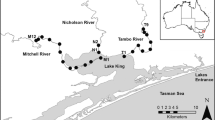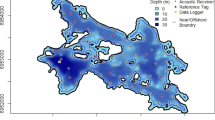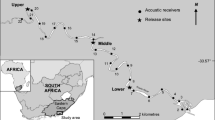Abstract
Many species of fish move between ocean and estuarine habitats; however, there is little evidence of the magnitude of fish undertaking these movements particularly over short time scales. Such information is critical in understanding the connectivity between these major habitats. We used an acoustic camera to observe the entire entrance of a small estuary over a 4-month period during 3 h of ebb and flood tides and during day and night, which allowed us to count all fish passing through the entrance and observe their schooling behaviour. Nearly 30,000 fish transited in 60 h of observation over the study period, with a mean of 1396 (±240 S.E.) fish per 3 h deployment and a maximum of 4636 fish per 3 h. Of these, 20,170 entered the estuary while 7751 exited. Movements of fish were closely related to tidal flow when fish movement peaked during the middle of the tide. While the majority of fish swam with the tide, approximately 32 % swam against the tidal current. The schooling behaviour of transiting fish varied between fish entering and exiting the estuary, with incoming fish far more likely to school than those exiting. This may be an antipredator behaviour but also related to group navigation. This study has provided insights into the tight coupling of estuaries and ocean, and the tidal influence on the mass movements of fish.




Similar content being viewed by others
References
Able K.W. 2005. A re-examination of fish estuarine dependence: evidence for connectivity between estuarine and ocean habitats. Estuarine Coastal and Shelf Science 64: 5–17.
Able K.W., T.M. Grothues, and I.M. Kemp. 2013. Fine-scale distribution of pelagic fishes relative to a large urban pier. Marine Ecology Progress Series 476: 185–198.
Arnold G.P., M. Greer Walker, L.S. Emerson, and B.H. Holford. 1994. Movements of cod (Gadus morhua L.) in relation to the tidal streams in the southern North Sea. ICES Journal of Marine Science 51: 207–232.
Beck M.W., K.L. Heck, K.W. Able, D.L. Childers, D.B. Eggleston, B.M. Gillanders, B. Halpern, C.G. Hays, K. Hoshino, T.J. Minello, R.J. Orth, P.F. Sheridan, and M.P. Weinstein. 2001. The identification, conservation, and management of estuarine and marine nurseries for fish and invertebrates. Bioscience 51: 633–641.
Becker A., P.D. Cowley, A.K. Whitfield, J. Järnegren, and T.F. Næsje. 2011. Diel fish movements in the littoral zone of a temporarily closed South African estuary. Journal of Experimental Marine Biology and Ecology 406: 63–70.
Becker A., and I.M. Suthers. 2014. Predator driven diel variation in abundance and behaviour of fish in deep and shallow habitats of an estuary. Estuarine Coastal and Shelf Science 144: 82–88.
Becker A., A.K. Whitfield, P.D. Cowley, J. Järnegren, and T.F. Næsje. 2013. Potential effects of artificial light associated with anthropogenic infrastructure on the abundance and foraging behaviour of estuary associated fishes. Journal of Applied Ecology 50: 43–50.
Bennett B.A. 1989. A comparison of the fish communities in nearby permanently open, seasonally open and normally closed estuaries in the South-Western Cape, South Africa. South African Journal of Marine Science 8: 43–55.
Berkstrom C., M. Gullstrom, R. Lindborg, A.W. Mwandya, S.A.S. Yahya, N. Kautsky, and M. Nystrom. 2012. Exploring ‘knowns’ and ‘unknowns’ in tropical seascape connectivity with insights from East African coral reefs. Estuarine Coastal and Shelf Science 107: 1–21.
Blaber S.J.M., and T.G. Blaber. 1980. Factors affecting the distribution of juvenile estuarine and inshore fishes. Journal of Fish Biology 17: 143–162.
Bode N.W.F., D.W. Franks, and A.J. Wood. 2012. Leading from the front? Social networks in navigating groups. Behavioral Ecology and Sociobiology 66: 835–843.
Bretsch K., and D.M. Allen. 2006. Tidal migrations of nekton in salt marsh intertidal creeks. Estuaries and Coasts 29(3): 474–486.
Burwen D.L., S.J. Fleischman, and J.D. Miller. 2010. Accuracy and precision of salmon length estimates taken from DIDSON sonar images. Transactions of the American Fisheries Society 139: 1306–1314.
Cavagna A., A. Cimarelli, I. Giardina, G. Parisi, R. Santagati, F. Stefanini, and M. Viale. 2010. Scale-free correlations in starling flocks. Proceedings of the National Academy of Sciences of the United States of America 107: 11865–11870.
Cavagna A., S.M.D. Queiros, I. Giardina, F. Stefanini, and M. Viale. 2013. Diffusion of individual birds in starling flocks. Proceedings of the Royal Society B-Biological Sciences 280.
Claridge P.N., I.C. Potter, and M.W. Hardisty. 1986. Seasonal changes in movements, abundance, size composition and diversity of the fish fauna of the Severn Estuary. Journal of the Marine Biological Association of the United Kingdom 66: 229–258.
Codling E.A., J.W. Pitchford, and S.D. Simpson. 2007. Group navigation and the "many-wrongs principle" in models of animal movement. Ecology 88: 1864–1870.
Collins D.G., and J.M. Melack. 2014. Biological and chemical responses in a temporarily open/closed estuary to variable freshwater inputs. Hydrobiologia 734: 97–113.
Dingle H., and V.A. Drake. 2007. What is migration?. Bioscience 57: 113–121.
Elsdon T.S., B.K. Wells, S.E. Campana, B.M. Gillanders, C.M. Jones, K.E. Limburg, D.H. Secor, S.R. Thorrold, and B.D. Walther. 2008. Otolith chemistry to describe movements and life-history parameters of fishes: hypotheses, assumptions, limitations and inferences. In Oceanography and marine biology: an annual review, vol Vol 46, 297–29+. Boca Raton: CRC Press-Taylor and Francis Group.
Forward R.B., and R.A. Tankersley. 2001. Selective tidal-stream transport of marine animals. Oceanography and marine biology: an annual review 39: 305–353.
Gibson R.N. 2003. Go with the flow: tidal migration in marine animals. Hydrobiologia 503: 153–161.
Gillanders B.M. 2005. Using elemental chemistry of fish otoliths to determine connectivity between estuarine and coastal habitats. Estuarine Coastal and Shelf Science 64: 47–57.
Gillanders B.M., K.W. Able, J.A. Brown, D.B. Eggleston, and P.F. Sheridan. 2003. Evidence of connectivity between juvenile and adult habitats for mobile marine fauna: an important component of nurseries. Marine Ecology-Progress Series 247: 281–295.
Gillanders B.M., and M.J. Kingsford. 1996. Elements in otoliths may elucidate the contribution of estuarine recruitment to sustaining coastal reef populations of a temperate reef fish. Marine Ecology Progress Series 141: 13–20.
Grunbaum D. 1998. Schooling as a strategy for taxis in a noisy environment. Evolutionary Ecology 12: 503–522.
Handegard N.O., K.M. Boswell, C.C. Ioannou, S.P. Leblanc, and D.B. Tjostheim. 2012. The dynamics of coordinated group hunting and collective information transfer among schooling prey. Current Biology 22: 1213–1217.
Herbert-Read J.E., A. Perna, R.P. Mann, T.M. Schaerf, D.J.T. Sumpter, and A.J.W. Ward. 2011. Inferring the rules of interaction of shoaling fish. Proceedings of the National Academy of Sciences of the United States of America 108: 18726–18731.
Hilbe J.M. 2011. Negative binomial regression. Cambridge: Cambridge University Press.
Hoeksema S.D., and I.C. Potter. 2006. Diel, seasonal, regional and annual variations in the characteristics of the ichthyofauna of the upper reaches of a large Australian microtidal estuary. Estuarine Coastal and Shelf Science 67: 503–520.
James N.C., P.D. Cowley, A.K. Whitfield, and H. Kaiser. 2008. Choice chamber experiments to test the attraction of postflexion Rhabdosargus holubi larvae to water of estuarine and riverine origin. Estuarine Coastal and Shelf Science 77: 143–149.
Lacoste K., J. Munro, M. Castonguay, F.J. Saucier, and J.A. Gagné. 2001. The influence of tidal streams on the pre-spawning movements of Atlantic herring, Clupea harengus L., in the St Lawrence estuary. ICES Journal of Marine Science 58: 1286–1298.
Lee S.H., H.K. Pak, and T.S. Chon. 2006. Dynamics of prey-flock esca** behavior in response to predator’s attack. Journal of Theoretical Biology 240: 250–259.
Montgomery J.C., N. Tolimieri, and O.S. Haine. 2001. Active habitat selection by pre-settlement reef fishes. Fish and Fisheries 2: 261–277.
Moursund R.A., T.J. Carlson, and R.D. Peters. 2003. A fisheries application of a dual-frequency identification sonar acoustic camera. ICES Journal of Marine Science 60: 678–683.
Naesje T.F., P.D. Cowley, O.H. Diserud, A.R. Childs, S.E. Kerwath, and E.B. Thorstad. 2012. Riding the tide: estuarine movements of a sciaenid fish, Argyrosomus japonicus. Marine Ecology Progress Series 460: 221–232.
Pattrick P., and N. Strydom. 2014. Recruitment of fish larvae and juveniles into two estuarine nursery areas with evidence of ebb tide use. Estuarine Coastal and Shelf Science 149: 120–132.
Pitcher T.J., and J.K. Parrish. 1993. Functions of shoaling behaviour in teleosts. In Behaviour of teleost fishes, ed. T.J. Pitcher, 363–440. London: Chapman and Hall.
Pollard D.A. 1994. A comparison of fish assemblages and fisheries in intermittently open and permanently open coastal lagoons on the south coast of New South Wales, South Eastern Australia. Estuaries 17: 631–646.
Core Team R.. 2014. A language for statistical computing. R Foundation for Statistical Computing.
Rieucau G., K.M. Boswell, M.E. Kimball, G. Diaz, and D.M. Allen. 2015. Tidal and diel variations in abundance and schooling behaviour of estuarine fish within an intertidal salt marsh pool. Hydrobiologia 753: 149–162.
Roy P.S., R.J. Williams, A.R. Jones, I. Yassini, P.J. Gibbs, B. Coates, R.J. West, P.R. Scanes, J.P. Hudson, and S. Nichol. 2001. Structure and function of south-east Australian estuaries. Estuarine Coastal and Shelf Science 53: 351–384.
Ryer C.H., and B.L. Olla. 1998. Effect of light on juvenile walleye pollock shoaling and their interaction with predators. Marine Ecology Progress Series 167: 215–226.
Shaw, E. 1970. Schooling in fishes: Critique and review. Development and evolution of behaviour (eds L.R. Aronson, E. Tobach, D.S. Lehrman and J.S. Rosenblatt), pp. 452–480. Freeman, San Francisco.
Sheaves M., R. Baker, I. Nagelkerken, and R.M. Connolly. 2015. True value of estuarine and coastal nurseries for fish: incorporating complexitya and dynamics. Estuaries and Coasts 38: 401–414.
Simons A.M. 2004. Many wrongs: the advantage of group navigation. Trends in Ecology and Evolution 19: 453–455.
Sogard S.M. 1992. Variability in growth-rates of juvenile fishes in different estuarine habitats. Marine Ecology-Progress Series 85: 35–53.
Tagliapietra D., and A.V. Ghirardini. 2006. Notes on coastal lagoon tyology in the light of the EU Water Framework Firective: Italy as a case study. Aquatic conservation: marine and freshwater ecosystems 16: 457–467.
Trancart T., P. Lambert, E. Rochard, F. Daverat, J. Coustillas, and C. Roqueplo. 2012. Alternative flood tide transport tactics in catadromous species: Anguilla anguilla, Liza ramada and Platichthys flesus. Estuarine Coastal and Shelf Science 99: 191–198.
Webster M.S., P.P. Marra, S.M. Haig, S. Bensch, and R.T. Holmes. 2002. Links between worlds: unraveling migratory connectivity. Trends in Ecology and Evolution 17: 76–83.
Whitfield A.K. 1998. Biology and ecology of fishes in southern African estuaries, 223. Ichthyological monographs of the J.L.B. Smith Institute of Ichthyology.
Wood S.N. 2006. Generalized additive models. Chapman and Hall/CRC, Boca Raton: An introduction with R.
Wood S.N. 2011. Fast stable restricted maximum likelihood and marginal likelihood estimation of semiparametric generalized linear models. Journal of the Royal Statistical Society: Series B (Statistical Methodology) 73: 3–36.
Zuur A.F., E.N. Ieno, N.J. Walker, A.A. Saveliev, and G.M. Smith. 2009. Mixed effect models and extensions in ecology with R. New York: Springer.
Acknowledgments
Funding for this research was provided by the School of Biological, Earth and Environmental Science (BEES) at the University of New South Wales. The DIDSON was funded by Australian Research Council grant LE10010059. Logistical support and advice was provided by the Warringah Council.
Author information
Authors and Affiliations
Corresponding author
Rights and permissions
About this article
Cite this article
Becker, A., Holland, M., Smith, J.A. et al. Fish Movement Through an Estuary Mouth Is Related to Tidal Flow. Estuaries and Coasts 39, 1199–1207 (2016). https://doi.org/10.1007/s12237-015-0043-3
Received:
Revised:
Accepted:
Published:
Issue Date:
DOI: https://doi.org/10.1007/s12237-015-0043-3




